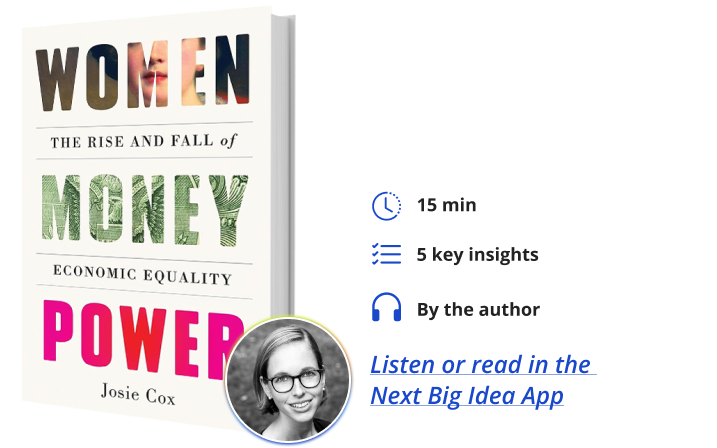Josie Cox is a journalist, editor, and broadcaster. She has worked for a broad range of media outlets in Germany, Switzerland, the UK, and the U.S., including Reuters, the Wall Street Journal, and The Independent, where she served as business editor. Cox was a fully funded 2020/2021 Knight-Bagehot Fellow at Columbia Journalism School. She has an MBA from Columbia Business School and is also an associate instructor in the Strategic Communications program at Columbia’s School of Professional Studies.
Below, Josie shares five key insights from her new book, Women Money Power: The Rise and Fall of Economic Equality. Listen to the audio version—read by Josie herself—in the Next Big Idea App.

1. So many heroes have been forgotten.
The cast of women who—since the Second World War—have fought tirelessly for economic rights and legal and social change is populous and remarkable but—to a large extent—unsung. One of my favorite parts of researching and writing this book was delving into the characters who made history but never got the credit they deserved.
We’ve all heard of the Rosie the Riveters—for example—the women who entered the paid labor market during the war, who took over the jobs that had up until that point been reserved for men, and who kept the economy running. But we rarely spend time actually contemplating who these individual people really were, what they experienced, and the resentment many of them felt when—after the war ended—they were forced back out of paid work and into domestic labor, simply because that’s what society’s norms at the time dictated.
One such Rosie the Riveter, now in her late 90s, helped me document what it really was like as a young woman, an American teenager, to build aircraft in the 1940s—to earn her own money, a paycheck much smaller than that of any man doing a similar job, but a paycheck of her own. It was a revolutionary moment for women and work, as well as the shape and dynamics of the paid labor market.
2. Economic empowerment doesn’t start with money.
Indeed, so much female economic empowerment comes down to personal freedom, freedom of choice, and, therefore, of course, reproductive freedom. Reproductive rights and economic empowerment are inextricably linked. For that reason, I focused squarely on the wild, wonderful, and, at times, cinematic tale of how the first oral birth control pill was developed and ultimately got approved by the U.S. Food and Drug Administration in 1960.
“Reproductive rights and economic empowerment are inextricably linked.”
Many of us are familiar with Margaret Sanger, the birth control advocate whose eugenicist legacy shone a stark light on the dark side of the birth control movement. But few of us have heard of Katharine Dexter McCormick, a brilliant, fearless, and driven woman who provided a huge portion of the funding required to make the contraceptive pill a reality.
Dexter McCormick is just one example of a woman who radically changed the course of history, whose grit, vision, and determination altered the lives of countless people, but whose name rarely appears in a history book or an academic syllabus.
3. Feminism has many faces.
The 1970s were a decade of particular legal and social progress towards women’s rights, but while many women—from Betty Friedan to Ruth Bader Ginsburg—have been singled out and hailed as the most important champions of their day, true progress was only possible because of the voices, actions and resolves of the many. Again, many of the unsung heroes here deserve the most credit.
Pauli Murray was a remarkable legal scholar and activist, who throughout her life powerfully illuminated the intersecting goals and challenges of the feminist and Civil Rights movements. Murray—a Black woman who throughout her life struggled with her gender identity—was a tireless advocate for those who didn’t have a voice, but crucially, she also understood that real change often has to begin with the basics: the legal framework upon which so many of our cultural norms and mores are based.
The late Supreme Court Justice Ruth Bader Ginsburg herself noted that in much of the work she did, she was “standing on [Murray’s] shoulders.” Murray also fostered a decades-long friendship with Eleanor Roosevelt and co-founded the National Organization for Women with Betty Friedan. Her name remains unfathomably obscure.
4. Progress is rarely linear.
Legally, so much was achieved in the 1970s and 1980s. Until the Equal Credit Opportunity Act of 1974, for example, a bank still had the legal right to refuse a woman a credit card based only on her sex. Until 1978, a woman could be fired from her job for getting pregnant. Until 1988, a woman without a male co-signer could still be refused business financing. The gender pay gap also became significantly narrower during that time.
But then, around the late 1980σ and into the early 1990s, something shifted. The trajectory started to flatten. Although the 1990s were, in many regards, a time of progress in terms of more women moving into visible political and business leadership, episodes like the Anita Hill and Monica Lewinsky hearings, as well as the emergence of the hyper-sexualized portrayal of women in pop culture and media, proved that real, meaningful progress towards gender equality was still elusive.
In 1993, President Bill Clinton signed the Family and Medical Leave Act into law. It was hailed at the time as one of the greatest policy steps designed to close the gender pay gap and accommodate more women working in the paid labor market.
“Until 1978, a woman could be fired from her job for getting pregnant.”
However, research has shown, counterintuitively, that the FMLA might actually have contributed to the stalling of the gender wage convergence—the rate at which women’s incomes were closing in on men’s. Much of this is because of this pesky, hard-to-define, but oh-so-important thing called culture.
By the 1990s, women were, in many respects, absolutely equal to men—at least in the eyes of the law—but social norms, cultural roles, heuristics, and biases have, in many cases, proved extremely pervasive and resistant to change. And indeed, that’s something we’re still seeing evidence of everywhere today.
5. We can’t give up hope.
We have not yet achieved economic equality between the genders. Progress over the last two and even three decades has not been particularly encouraging. Especially here in the U.S., where reproductive rights have come under fierce attack and where COVID-19 has triggered a hardening of traditional gender norms, it can seem like we’re actually moving backward rather than forwards.
But speaking to the people at the center of the fight for economic gender equality has made me realize that there are reasons to be optimistic, and all of us have a role to play in creating a labor market and a wider society in which everyone, regardless of their gender—or their sexuality, identity or race, for that matter—can reach their full personal and professional potential.
We need to become better communicators. It might sound obvious, but to bridge divides, we need to find common ground. Common ground means common values. Common principles. Common respect.
When women prosper, we all prosper. When women can earn and work and build a career and follow a professional passion; when women can start companies, and get funded, and get hired and get promoted at the same rate as their male counterparts without worrying that they’re going to be assessed or judged by their gender, everyone wins.
I had the opportunity to talk to the CEO of a very large company. What he said has stayed with me, and I’ve reflected on it almost every day since. I asked him why he thought his organization still had a very large gender pay gap—a sizeable difference between the average man’s and average woman’s paycheck. “Sometimes,” he said in response, “when a woman has a baby, her priorities shift, and she’s not as professionally ambitious as she was previously.”
“How might a woman think differently if she didn’t still find herself having to compromise professional success for personal fulfillment?”
This answer absolutely floored me. Sure, some women intentionally choose to leave the paid labor market when becoming mothers. Sure, some women work fewer hours outside of the home when they have a kid because that makes sense for their particular situation. But let’s dig deeper: Why is that? Is this really a decision that—as the CEO I was chatting to seemed to be framing it—is entirely, or at least predominantly, in the hands of the woman?
How might a woman think differently if affordable child care were readily available and reliable across the whole of America? How might a woman think differently if cultural norms didn’t still—in many cases—dictate that a woman in a heterosexual relationship should be the default primary caregiver? How might a woman think differently if her workplace offered her the flexibility and accommodations that she needed to work as much as she wanted while also caring for her family?
In short, how might a woman think differently if she didn’t still find herself having to compromise professional success for personal fulfillment in a way that a man so frequently doesn’t?
More progress can be fueled by better conversation and more understanding. From atop the lofty heights of leadership, it can be hard to imagine the actual lived experiences of those below. We need to make more of an effort to connect, and we need to ask ourselves: What might I not understand about what someone else is going through?
The women whom I profile in my book should serve as an inspiration to us all as we collectively continue to work on building a more equal world. We can learn from their compassion, their conviction, and their kindness. So many of them understood the plight of others and—for a time at least—put their own interests aside in the interest of the common good.
Progress will never be linear—and no, it will never be easy—but we need to make sure that we’re always heading in the right direction.
To listen to the audio version read by author Josie Cox, download the Next Big Idea App today:































